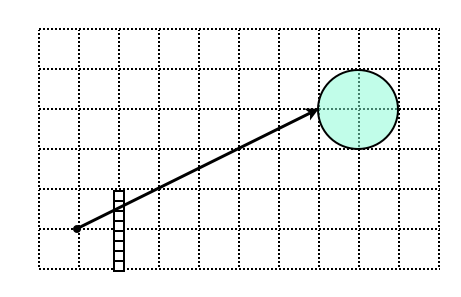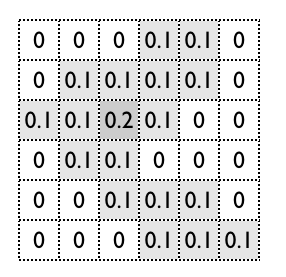
Question 1
Suppose we are determining the intensity of the pixel above (The pixel is shown by the dotted line box) with a value between 0 and 1. What value will the pixel have if sampling is performed by:
1/16 1/16 1/16 1/16 1/2 1/16 1/16 1/16 1/16
Question 2:
The image below shows an eye ray from the camera hitting a glass sphere.
Draw the reflected and transmitted rays. Use Snell's law to compute refraction angles, assuming the speed of light in the sphere is 50% of the speed in air.

Question 3:
We can rearrange the terms in Snell's Law to get:

What happens when this value is greater than one? Under what circumstances will this occur?
Question 4:
Consider a cloud represented as the array of densities below:

The cloud has uniform colour C(x,y) = (1,1,1) and transparency alpha(x,y) equal to the density values above. The sky behind the cloud is blue C = (0,0,1).
Suppose we are looking up at the cloud from below. Assume the cloud is far enough away that we can render it with an orthographic camera (parallel rays) with little distortion.
Cast six equally spaced vertical rays through the cloud, taking samples distance 1 apart. Calculate the pixel values for each ray.
What happens to the result if we take samples at twice the frequency? or half? Is this behaviour correct? How could we adapt the algortihm from lectures to make it less sensitive to such changes?
Assignment Discuss any issues with the assignment.Non-examinable Questions
Use this algorithm to compute anti-aliased pixel values for the line from P(3,3) to Q(10,5) from Q1.
What are the trade-offs between this and a post-filtered version of Bresenham's algorithm?
Take a look at Eric Chan's method for computing anti-aliased lines using the GPU. What tradeoffs are involved in using this method?